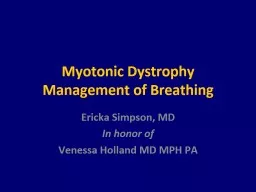

Management of Breathing Ericka Simpson MD In honor of Venessa Holland MD MPH PA May 18 2019 Houston Methodist Neurological Institute Venessa Holland MD RESPIRATORY MUSCLE IMPAIRMENT Early identification of weakness ID: 909202
Download Presentation The PPT/PDF document "MDF Myotonic Dystrophy Day" is the property of its rightful owner. Permission is granted to download and print the materials on this web site for personal, non-commercial use only, and to display it on your personal computer provided you do not modify the materials and that you retain all copyright notices contained in the materials. By downloading content from our website, you accept the terms of this agreement.
Slide1
MDF Myotonic Dystrophy Day Management of Breathing
Ericka Simpson, MD
In honor
of
Venessa Holland MD MPH PA
May 18, 2019
Houston Methodist Neurological Institute
Slide2Venessa Holland, MD
Slide3RESPIRATORY MUSCLE IMPAIRMENT
Early identification of weakness
Provide symptom relief
Improve quality of life
Prolong life
Slide4Mechanics of Respiration<iframe
width="560" height="315"
src
="https://www.youtube.com/embed/MPovpAXcmIU"
frameborder
="0" allow="
autoplay
; encrypted-media" allowfullscreen></iframe>
https://youtu.be/MPovpAXcmIU
Slide5MOST COMMON SYMPTOMS OF RESPIRATORY WEAKNESS
Feeling like you can not get enough air
Shortness of breath and sweating
Speech problems
Coughing when eating or swallowing
Slide6MOST COMMON SYMPTOMS OF RESPIRATORY WEAKNESSWeak cough with increased secretions
Inability to clear secretions
Feeling tired and fatigued
Waking up often when you sleep
Slide7CLINICAL SIGNS OF INSUFFICENT VENTILATION
Dyspnea - shortness of breath
Orthopnea - shortness of breath when lying flat
Rapid shallow breathing
Accessory muscle use
Thoracoabdominal paradox - inward movement of abdomen during inspiration
Hypercapnia - elevated carbon dioxide in blood
Hypoxemia - low oxygen level
Slide8CLINICAL SIGNS OF INSUFFICENT VENTILATIONNOCTURNAL HYPOVENTILATION
Choking
Insomnia - can not sleep
Daytime Hypersomnolence - excessive sleepiness during the day
Morning Headaches
Fatigue
Impaired Cognition
Slide9CLINICAL SIGNS OF OROPHARYNGEAL MUSCLE IMPAIRMENTDifficulty swallowing
Difficulty clearing throat or coughing
Nasal regurgitation of food or liquids
Weak chewing
Protruding tongue
Slide10CLINICAL SIGNS OF OROPHARYNGEAL MUSCLE IMPAIRMENTDifficulty speaking
Nasal speech (palatal muscle weakness)
Low Intensity (
hypophonia
)
Prolonged speech intensify symptoms
Slide11CLINICAL SIGNS OF RESPIRATORY MUSCLE IMPAIRMENTINEFFECTIVE COUGH (COMPLICATIONS)
Aspiration of contents in mouth/throat into lungs
Retention of secretions or inability to swallow (drooling)
Pneumonia due to accumulation of secretions/bacteria
Atelectasis or Lung collapse with poor oxygen intake and poor carbon dioxide exit
Slide12Slide13Pulmonary Functions at Onset ofBreathing Weakness
Cho, et al. Ann
Rehabil
Med 2016;40(1):74-80
Slide14DIAGNOSTIC STUDIES
Blood Gas
Imaging Testing
Chest x-ray
CT of chest
MRI
Doppler of lower extremities
Slide15DIAGNOSTIC STUDIES
Most common diagnostic tool to evaluate respiratory muscle weakness
Pulmonary Function Testing
FEV1, FVC, FEV1/FVC
NIF and VC
MIPS and MEPS
Slide16PULMONARY FUNCTION STUDIES
Forced Expiratory Volume 1 (FEV) - the amount of air that can be exhaled in 1 second
Forced Vital Capacity (FVC) - the maximum amount of air blown out from full inspiration with maximal speed and effort
Vital Capacity (VC) - the maximum amount of air blown out from full inspiration
Slide17PULMONARY FUNCTION STUDIESNegative Inspiratory Force (NIF) - measurement of respiratory muscle weakness
Maximum Inspiratory Pressure (MIP) - measures strength of diaphragm
Maximum Expiratory Pressure(MEP) - measures strength of abdominal muscles and other expiratory muscles
Slide18NONINVASIVE VENTILATIONDURING RESPIRATORY COMPROMISE
Slide19RESPIRATORY SUPPORTBIPAP –
Bilevel
Positive Airway Pressure
BIPAP/ST-
Bilevel
Positive Airway Pressure/Spontaneous - Timed
AVAPS – Average Volume Assured Pressure Support (Set by the operator)
IVAP – Intelligent Volume Assured Pressure Support (Height, RR and Target Alveolar ventilation)
Slide2020
TREATMENT GOALS NIV
LUNG VOLUME RECRUITMENT
Problem
Solution
Slow decline in VC
Augment lung volumes
Prevent
microatelectasis
Positive
pressure to recruit alveoli
Improve
lung compliance
Decrease atelectasis
Improve cough
effectiveness
Volume expansion and increase peak expiratory flow
Correct V/Q mismatch
Through
alveolar recruitment
Slide21BIPAP/AVAPS
Slide22Slide23Properly size and fit the patient
Full-face masks
Nasal pillows
Nasal mask
MASK SIZE AND FIT
Slide24RESPIRATORY FAILUREELECTIVE INTUBATION
VC less than 15 - 20 ml/kg
NIF less than - 25 – 30 cm H20 pressure
Unable to clear secretions - poor cough
Clinical signs of respiratory distress
Difficulty swallowing or speaking
PCO2 above 50
Slide25WEANING FROM INTUBATION
Muscle strength has to be improved
VC is > 15 ml/kg and NIF
>
30 after improvement with treatment
Able to handle oral secretions
Ability to follow commands
Ability to cough
Satisfactory weaning parameters
Cuff leak
Slide26FACTORS CONTRIBUTING TO REINTUBATION
Lower VC at time of
extubation
Atelectasis
Underlying lung disease
Need for continuous noninvasive ventilation after
extubation
due to exacerbation of MG
Aspiration Ineffective coughHigh
oxyen
requirement
Elevated pCO2
Slide27RESPIRATORY SUPPORT SYSTEMS
Airway Clearance
Suction machine
Cough assistance device
Vest
Metaneb
Bronchodilators with nebulizer or
metanebAlbuterol
Mucolytics
Slide28METANEB SYSTEM
Slide29The MetaNeb® Systems
The MetaNeb® 3.0 System
The MetaNeb® 4.0 System
Page
29
Slide30METANEB THERAPIESContinuous Positive Expiratory Pressure
Lung expansion for treatment and prevention of atelectasis
Continuous High Frequency Oscillation
Secretions mobilization therapy
Aerosol Mode
Aerosol therapy (inhalers or nebulizers)
Provides supplemental oxygen when needed
Slide31History
of
pneumothorax
Pulmonary
air
leak
Recent
pneumonectomy
Pulmonary hemorrhage
Myocardial infarction
Vomiting
The
MetaNeb
System
Absolute Contraindications
Relative
Contraindications
Untreated tension pneumothorax
Untrained or unskilled operator
Possible Adverse Reactions
Hyperventilation
Gastric distension
Decreased cardiac output
Increased intracranial pressure
Increased air trapping
Hyperoxygenation
Pneumothorax
Pulmonary air leak
Pulmonary hemorrhage
Slide32THE VEST
Slide33VEST THERAPY
Increase airflow in lungs
Creates cough like forces
Decrease secretion thickness
Helps move secretions from smaller airway to large airways for clearance
Slide34COUGH ASSIST DEVICEMECHANICAL INSUFFLATOR- EXSUFFLATOR
Slide35RESPIRATORY PROTECTION MECHANISMS
VACCINATIONS( if not contraindicated
)
FLU
PNEUMOVAX( Pneumovax 23 and Pneumovax 13)
SHINGLES
HAND WASHING
AVOID OF CROWDS
-
during respiratory season